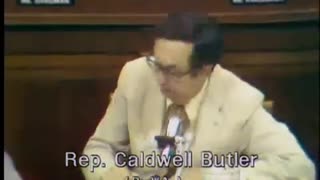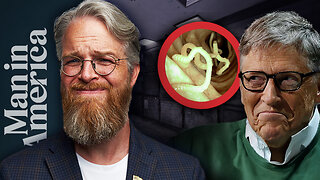Premium Only Content

The Medical Implications of Nuclear Power
The dark side of history: https://thememoryhole.substack.com/
The effects of the 1979 Three Mile Island nuclear accident are widely agreed to be very low by scientists in the relevant fields. The American Nuclear Society concluded that average local radiation exposure was equivalent to a chest X-ray and maximum local exposure equivalent to less than a year's background radiation.[1] The U.S. BEIR report on the Biological Effects of Ionizing Radiation states that "the collective dose equivalent resulting from the radioactivity released in the Three Mile Island accident was so low that the estimated number of excess cancer cases to be expected, if any were to occur, would be negligible and undetectable."[2] A variety of epidemiology studies have concluded that the accident has had no observable long term health effects.[3][4][5] One dissenting study is "a re-evaluation of cancer incidence near the Three Mile Island nuclear plant" by Dr Steven Wing of the University of North Carolina. In this study, Dr Wing and his colleagues argue that earlier findings had "logical and methodological problems" and conclude that "cancer incidence, specifically lung cancer and leukemia, increased following the TMI accident in areas estimated to have been in the pathway of radioactive plumes than in other areas."[6] Other dissenting opinions can be found in the Radiation and Public Health Project, whose leader, Joseph Mangano, has questioned the safety of nuclear power since 1985.[7][8][9]
Initial investigations
In the aftermath of the accident, the investigations focused on the amounts of radioactivity released by the accident. American Nuclear Society explained using the official radioactivity emission figures that "the average radiation dose to people living within ten miles of the plant was eight millirem, and no more than 100 millirem to any single individual. Eight millirem is about equal to a chest X-ray, and 100 millirem is about a third of the average background level of radiation received by US residents in a year".[1][10] To put this dose into context, while the average background radiation in the US is about 360 millirem per year, the Nuclear Regulatory Commission regulates all workers' of any US nuclear power plant exposure to radiation to a total of 5000 millirem per year.[11] Based on these low emission figures, early scientific publications on the health effects of the fallout estimated one or two additional cancer deaths in the 10-mile area around TMI.[8]
Worker overexposures
In the early days of the accident, three plant workers were known to have received extremity doses from entries into the Unit 2 auxiliary building. Ron Fountain, an auxiliary operator, hyperventilated while opening sample lines on March 28.[11] The following day, chemistry supervisor Ed Houser and radiation protection foreman Pete Velez received extremity doses while drawing a boron concentration sample from the health-physics lab inside the auxiliary building. [12]
Local resident reports
The official figures are too low to account for the acute health effects reported by some local residents and documented in two books;[12][13] such health effects require exposure to at least 100,000 millirems (100 rems) to the whole body - 1000 times more than the official estimates.[14] The reported health effects are consistent with high doses of radiation, and comparable to the experiences of cancer patients undergoing radio-therapy[15] but have many other potential causes.[14] The effects included "metallic taste, erythema, nausea, vomiting, diarrhea, hair loss, deaths of pets, farm and wild animals, and damage to plants."[16] Some local statistics showed dramatic one-year changes among the most vulnerable: "in Dauphin County, where the Three Mile Island plant is located, the 1979 death rate among infants under one year represented a 28 percent increase over that of 1978, and among infants under one month, the death rate increased by 54 percent."[8] Physicist Ernest Sternglass, a specialist in low-level radiation, noted these statistics in the 1981 edition of his book Secret Fallout: low-level radiation from Hiroshima to Three-Mile Island. In their final 1981 report, however, the Pennsylvania Department of Health, examining death rates within the 10-mile area around TMI for the 6 months after the accident, said that the TMI-2 accident did not cause local deaths of infants or fetuses.[17][18]
Scientific work continued in the 1980s, but focused heavily on the mental health effects due to stress,[8] as the Kemeny Commission had concluded that this was the sole public health effect.[19] A 1984 survey by a local psychologist of 450 local residents, documenting acute radiation health effects (as well as 19 cancers 1980-84 amongst the residents against an expected 2.6[16]), ultimately led the TMI Public Health Fund reviewing the data[20] and supporting a comprehensive epidemiological study by a team at Columbia University.[15]
Columbia epidemiological study
In 1990-1 a Columbia University team, led by Maureen Hatch, carried out the first epidemiological study on local death rates before and after the accident, for the period 1975-1985, for the 10-mile area around TMI.[3][19] Assigning fallout impact based on winds on the morning of March 28, 1979,[3] the study found no link between fallout and cancer risk.[8] The study found that cancer rates near the Three Mile Island plant peaked in 1982-3, but their mathematical model did not account for the observed increase in cancer rates, since they argued that latency periods for cancer are much longer than three years. From 1975 to 1979 there were 1,722 reported cases of cancer, and between 1981 and 1985 there were 2,831, signifying a 64 percent increase after the meltdown.[21] The study concludes that stress may have been a factor (though no specific biological mechanism was identified), and speculated that changes in cancer screening were more important.[19]
Wing review
Subsequently, lawyers for 2000 residents asked epidemiologist Stephen Wing of the University of North Carolina at Chapel Hill, a specialist in nuclear radiation exposure, to re-examine the Columbia study. Wing was reluctant to get involved, later writing that "allegations of high radiation doses at TMI were considered by mainstream radiation scientists to be a product of radiation phobia or efforts to extort money from a blameless industry."[16] Wing later noted that in order to obtain the relevant data, the Columbia study had to submit to what Wing called "a manipulation of research" in the form of a court order which prohibited "upper limit or worst case estimates of releases of radioactivity or population doses... [unless] such estimates would lead to a mathematical projection of less than 0.01 health effects."[16] Wing found cancer rates raised within a 10-mile radius two years after the accident by 0.034% +/- 0.013%, 0.103% +/- 0.035%, and 0.139% +/- 0.073% for all cancer, lung cancer, and leukemia, respectively.[6] An exchange of published responses between Wing and the Columbia team followed.[8] Wing later noted a range of studies showing latency periods for cancer from radiation exposure between 1 and 5 years due to immune system suppression.[16] Latencies between 1 and 9 years have been studied in a variety of contexts ranging from the Hiroshima survivors and the fallout from Chernobyl to therapeutic radiation; a 5-10 year latency is most common.[22]
Further studies
On the recommendation of the Columbia team, the TMI Public Health Fund followed up its work with a longitudinal study.[23] The 2000-3 University of Pittsburgh study[24] compared post-TMI death rates in different parts of the local area, again using the wind direction on the morning of 28 March to assign fallout impact, In contrast to the Columbia study, which estimated exposure in 69 areas, the Pittsburgh study drew on the TMI Population Registry, compiled by the Pennsylvania Department of Health. This was based on radiation exposure information on 93% of the population living within five miles of the nuclear plant - nearly 36,000 people, gathered in door-to-door surveys shortly after the accident.[25] The study found slight increases in cancer and mortality rates but "no consistent evidence" of causation by TMI.[24] Wing et al. criticized the Pittsburgh study for making the same assumption as Columbia: that the official statistics on low doses of radiation were correct - leading to a study "in which the null hypothesis cannot be rejected due to a priori assumptions."[26] Hatch et al. noted that their assumption had been backed up by dosimeter data,[23] though Wing et al. noted the incompleteness of this data, particularly for releases early on.[27]
In 2005 R. William Field, an epidemiologist at the University of Iowa, who first described radioactive contamination of the wild food chain from the accident[citation needed] suggested that some of the increased cancer rates noted around TMI were related to the area's very high levels of natural radon, noting that according to a 1994 EPA study, the Pennsylvania counties around TMI have the highest regional screening radon concentrations in the 38 states surveyed.[28] The factor had also been considered by the Pittsburgh study[24] and by the Columbia team, which had noted that "rates of childhood leukemia in the Three Mile Island area are low compared with national and regional rates."[3] A 2006 study on the standard mortality rate in children in 34 counties downwind of TMI found an increase in the rate (for cancers other than leukemia) from 0.83 (1979–83) to 1.17 (1984–88), meaning a rise from below the national average to above it.[22]
A paper in 2008 studying thyroid cancer in the region found rates as expected in the county in which the reactor is located, and significantly higher than expected rates in two neighboring counties beginning in 1990 and 1995 respectively. The research notes that "These findings, however, do not provide a causal link to the TMI accident."[29] According to Joseph Mangano (who is a member of The Radiation and Public Health Project, an organization with little credibility amongst epidemiologists,[30]) three large gaps in the literature include: no study has focused on infant mortality data, or on data from outside the 10-mile zone, or on radioisotopes other than iodine, krypton, and xenon.[8]
References
"What Happened and What Didn't in the TMI-2 Accident". American Nuclear Society. Archived from the original on 2011-07-17. Retrieved 2008-11-09.
National Research Council (US) Committee on the Biological Effects of Ionizing Radiation (1990). Health effects of exposure to low levels of ionizing radiation (BEIR V). Washington, DC: National Academies Press. p. 377. ISBN 978-0-309-03995-6. PMID 25032334. {{cite book}}: |website= ignored (help)
Maureen C. Hatch; et al. (1990). "Cancer near the Three Mile Island Nuclear Plant: Radiation Emissions". American Journal of Epidemiology. 132 (3). Oxford Journals: 397–412. doi:10.1093/oxfordjournals.aje.a115673. PMID 2389745.
Hatch MC, Wallenstein S, Beyea J, Nieves JW, Susser M; Wallenstein; Beyea; Nieves; Susser (June 1991). "Cancer rates after the Three Mile Island nuclear accident and proximity of residence to the plant". American Journal of Public Health. 81 (6): 719–724. doi:10.2105/AJPH.81.6.719. PMC 1405170. PMID 2029040.
R. J. Levin (2008), "Incidence of thyroid cancer in residents surrounding the three-mile island nuclear facility", Laryngoscope 118 (4), pp. 618–628 "These findings, however, do not provide a causal link to the TMI accident."
Wing, Steve; Richardson, David; Armstrong, Donna; Crawford, Douglas (January 1997). "A reevaluation of cancer incidence near the Three Mile Island nuclear plant: The collision of evidence and assumptions". Environmental Health Perspectives. 105 (1): 52–57. doi:10.1289/ehp.9710552. JSTOR 3433062. PMC 1469835. PMID 9074881.
Newman, Andy (November 11, 2003). "In Baby Teeth, a Test of Fallout; A Long-Shot Search for Nuclear Peril in Molars and Cuspids". The New York Times.
Mangano, Joseph (2004), "Three Mile Island: Health study meltdown", Bulletin of the atomic scientists, 60(5), pp.31-35
Fecht, Sarah (2004-04-08). "What Can We Do About Junk Science?". Popular Mechanics. Retrieved 2020-05-29.
"Three-Mile Island cancer rates probed". BBC News. 2002-11-01. Retrieved 2008-11-25.
"NRC: Fact Sheet on Biological Effects of Radiation". Retrieved 2008-12-29.
Katagiri Mitsuru and Aileen M. Smith (1989), Three Mile Island: The People's Testament - based on interviews with 250 residents between 1979 and 1988.
Robert Del Tredici (1982) The People of Three Mile Island, Random House, Inc.
GPU Utilities 91986), "Radiation And Health Effects: A Report on the TMI-2 Accident and Related Health Studies"
Sue Sturgis (2009) "FOOLING WITH DISASTER? Startling revelations about Three Mile Island disaster raise doubts over nuclear plant safety" Archived 2010-04-18 at the Wayback Machine, Facing South: Online Magazine of the Institute for Southern Studies, April 2009
Wing, Steven (2003) "Objectivity and Ethics in Environmental Health Science", Environmental Health Perspectives Volume 111, Number 14, November 2003
"Report doubts infant death rise from three mile island mishap". The New York Times. 1981-03-21. Retrieved 2008-12-29.
Walker, p234
Hatch MC, Wallenstein S, Beyea J, Nieves JW, Susser M (June 1991). "Cancer rates after the Three Mile Island nuclear accident and proximity of residence to the plant". American Journal of Public Health. 81 (6): 719–724. doi:10.2105/AJPH.81.6.719. PMC 1405170. PMID 2029040.
Moholdt B. Summary of acute symptoms by TMI area residents during accident. In:Proceedings of the workshop on Three Mile Island dosimetry. Philadelphia:Academy of Natural Sciences, 1985.
Mangano, Joseph. "Three Mile Island: Health Study Meltdown". Bulletin of the Atomic Scientists. Retrieved 1 May 2014.
Mangano, Joseph (2006), "A short latency between radiation exposure from nuclear plants and cancer in young children", International journal of health services, vol:36 iss:1 pg:113-135
Hatch; et al. (1997). "Comments on "A Re-Evaluation of Cancer Incidence Near the Three Mile Island Nuclear Plant". Environmental Health Perspectives. 105 (1): 1. doi:10.1289/ehp.9710512. PMC 1469856. PMID 9074862.
Talbott Evelyn O.; et al. (2000). "Mortality Among the Residents of the Three Mile Accident Area: 1979–1992". Environmental Health Perspectives. 108 (6): 545–52. doi:10.1289/ehp.00108545. PMC 1638153. PMID 10856029.; Talbott Evelyn O.; et al. (2003). "Long-Term Follow-up of the Residents of the Three Mile Island Accident". Environmental Health Perspectives. 111 (3): 341–48. doi:10.1289/ehp.5662. PMC 1241392. PMID 12611664.
Holzman (2003), "Cancer and three mile island", Environmental health perspectives, vol:111 iss:3 pg:A166 -A167
Wing, S. and Richardson, D. (2000), "Collision of Evidence and Assumptions: TMI Déjà View", Environmental Health Perspectives, 108(12), December 2000
Wing, S.; Richardson, D.; Armstrong, D. (1997). "Reply to Comments on "A Reevaluation of Cancer Incidence near the Three Mile Island"". Environmental Health Perspectives. 105 (3): 266–268. doi:10.2307/3433255. JSTOR 3433255. PMC 1469992. PMID 9171981.
R. W. Field (2005), "Three Mile Island epidemiologic radiation dose assessment revisited: 25 years after the accident", Radiation Protection Dosimetry 113 (2), pp. 214-217
RJ Levin (2008), "Incidence of thyroid cancer in residents surrounding the three mile island nuclear facility", Laryngoscope 118 (4), pp. 618-628
Newman, Andy (2003-11-11). "In Baby Teeth, a Test of Fallout; A Long-Shot Search for Nuclear Peril in Molars and Cuspids". The New York Times.
If You Love This Planet is a 1982 Canadian documentary short film directed by Terre Nash, produced by Studio D and distributed by the National Film Board of Canada.
Plot
The film is a recording of a lecture given to SUNY Plattsburgh students by Australian physician and anti-nuclear activist Dr. Helen Caldicott about the dangers posed by nuclear weapons. While Caldicott speaks about the dangers of nuclear war and what it could mean in terms of casualties, Nash cuts from the speech to black-and-white images of the bombings of Hiroshima and Nagasaki.[1]
Production
The film was created by Studio D with a budget of $70,117 (equivalent to $180,848 in 2021). The NFB's Board of Governors stated that the film was the "hottest film since Not a Love Story". The Ministry of External Affairs opposed including Ronald Reagan in the film.[2] Footage from Jap Zero, a 1943 United States Department of War film, featuring Reagan was used in the film.[3]
Release
The film was meant to be shown at the United Nations's Conference on Disarmament. It debuted in the United Kingdom when it was screened by the London Socialist Film Co-op.[4]
The Canadian Broadcasting Corporation declined to broadcast the film, "because it takes a strong position on nuclear arms and does not give a balanced and objective view of the subject", and that they could not counter the film as it would be difficult to assemble a discussion panel including supporters of nuclear war.[5] The film was later shown on the CBC newsmagazine The Journal. [2]
Reception
Reagan administration
On 13 January 1983,[6] the American distributors of If You Love This Planet, Acid Rain: Requiem or Recovery, and Acid from Heaven were ordered to register as foreign agents by the United States Department of Justice citing the Foreign Agents Registration Act. The films were also ordered to be labeled as political propaganda.[1] Barry Keene, a member of the California State Senate, filed a lawsuit against the order. In 1983, an injunction against the DOJ was issued by U.S. District Judge Raul Anthony Ramirez. In 1986, the Supreme Court of the United States agreed to hear the case; on 28 April 1987, in Meese v. Keene, it ruled five to three in favor of the DOJ.[7][8][6]
Accolades
If You Love This Planet was the seventh film by the NFB to receive an Academy Award.[9] Nash thanked Reagan in her Oscar acceptance speech for the added publicity.[10]
Award Date of ceremony Category Recipient(s) Result Ref.
Academy Awards April 11, 1983 Best Documentary Short If You Love This Planet Won [11]
Legacy
In 1992, Caldicott published the book, If You Love This Planet: A Plan to Heal the Earth and, from July 2008 to November 2012, hosted a weekly radio program called If You Love This Planet.[12][13]
See also
Eight Minutes to Midnight: A Portrait of Dr. Helen Caldicott, a 1981 feature-length documentary film
References
Evans 1991, p. 283.
Evans 1991, p. 283-284.
Beard & White 2002, p. 23.
Matthew Hays, "Montreal Oscar Stories: Two of the city's award-winners reminisce" Archived 2002-08-23 at the Wayback Machine Montreal Mirror, March 21, 1997. Accessed 2008.12.18.
Nelson, Joyce (1983). "Film Reviews/Terri Nash's "If You Love This Planet"". Cinema Canada. ISSN 1918-879X.
"Meese v. Keene". FindLaw. Archived from the original on 20 November 2022.
Evans 1991, p. 284-285.
"Justices Accept 'Propaganda' Case: Supreme Court To Hear 'Propaganda' Films Case". Los Angeles Times. 22 April 1986. Archived from the original on 20 November 2022.
"'The Mask' Publicist In N.Y." National Film Board. Archived from the original on 17 June 2023.
"If You Love This Planet". cfe.tiff.net. Canadian Film Encyclopedia. Retrieved 8 March 2023.
Evans 1991, p. 284.
"If you love this planet: A plan to heal the earth". Choice Reviews Online. 30 (2): 30–0879. 1992. doi:10.5860/choice.30-0879. S2CID 128697913.
"Program Information - IF YOU LOVE THIS PLANET WITH DR. HELEN CALDICOTT IS NOW OFF THE AIR|A-Infos Radio Project".
Works cited
Beard, William; White, Jerry, eds. (2002). North of Everything: English-Canadian Cinema Since 1980. The University of Alberta Press. ISBN 0-88864-398-5.
Evans, Gary (1991). In the National Interest: A Chronicle of the National Film Board of Canada from 1949 to 1989. University of Toronto Press. ISBN 0802027849.
External links
If You Love This Planet at IMDb Edit this at Wikidata
Watch If You Love This Planet on the NFB website
If You Love This Planet at AllMovie
If You Love This Planet Radio Program
Full film at Documentary.net
vte
Academy Award for Best Documentary Short Film
1941–1975
Churchill's Island (1941) No Award (1942) December 7th (1943) With the Marines at Tarawa (1944) Hitler Lives (1945) Seeds of Destiny (1946) First Steps (1947) Toward Independence (1948) A Chance to Live / So Much for So Little (1949) Why Korea? (1950) Benjy (1951) Neighbours (1952) The Alaskan Eskimo (1953) Thursday's Children (1954) Men Against the Arctic (1955) The True Story of the Civil War (1956) No Award (1957) Ama Girls (1958) Glass (1959) Giuseppina (1960) Project Hope (1961) Dylan Thomas (1962) Chagall (1963) Nine from Little Rock (1964) To Be Alive! (1965) A Year Toward Tomorrow (1966) The Redwoods (1967) Why Man Creates (1968) Czechoslovakia 1968 (1969) Interviews with My Lai Veterans (1970) Sentinels of Silence (1971) This Tiny World (1972) Princeton: A Search for Answers (1973) Don't (1974) The End of the Game (1975)
1976–2000
Number Our Days (1976) Gravity Is My Enemy (1977) The Flight of the Gossamer Condor (1978) Paul Robeson: Tribute to an Artist (1979) Karl Hess: Toward Liberty (1980) Close Harmony (1981) If You Love This Planet (1982) Flamenco at 5:15 (1983) The Stone Carvers (1984) Witness to War: Dr. Charlie Clements (1985) Women – for America, for the World (1986) Young at Heart (1987) You Don't Have to Die (1988) The Johnstown Flood (1989) Days of Waiting (1990) Deadly Deception: General Electric, Nuclear Weapons and Our Environment (1991) Educating Peter (1992) Defending Our Lives (1993) A Time for Justice (1994) One Survivor Remembers (1995) Breathing Lessons: The Life and Work of Mark O'Brien (1996) A Story of Healing (1997) The Personals (1998) King Gimp (1999) Big Mama (2000)
2001–present
Thoth (2001) Twin Towers (2002) Chernobyl Heart (2003) Mighty Times: The Children's March (2004) A Note of Triumph: The Golden Age of Norman Corwin (2005) The Blood of Yingzhou District (2006) Freeheld (2007) Smile Pinki (2008) Music by Prudence (2009) Strangers No More (2010) Saving Face (2011) Inocente (2012) The Lady in Number 6: Music Saved My Life (2013) Crisis Hotline: Veterans Press 1 (2014) A Girl in the River: The Price of Forgiveness (2015) The White Helmets (2016) Heaven Is a Traffic Jam on the 405 (2017) Period. End of Sentence. (2018) Learning to Skateboard in a Warzone (If You're a Girl) (2019) Colette (2020) The Queen of Basketball (2021) The Elephant Whisperers (2022) The Last Repair Shop (2023)
Categories:
1982 films1982 in the environmentEnglish-language Canadian filmsNational Film Board of Canada documentariesBest Documentary Short Subject Academy Award winnersDocumentary films about nuclear war and weaponsCanadian short documentary films1982 documentary filmsAnti–nuclear weapons movementAnti-nuclear filmsFilms about activistsNational Film Board of Canada short filmsQuebec films1980s English-language filmsFilm censorship in the United StatesFilms about the atomic bombings of Hiroshima and Nagasaki1980s Canadian films1980s short documentary filmsState University of New York at PlattsburghFilms shot in New York (state)
-
 8:57:26
8:57:26
The Memory Hole
6 months agoNixon Impeachment Hearings Day 7 (1974-07-30)
1.32K1 -
 22:35
22:35
GritsGG
13 hours agoThe KILO is BACK! The Best AR on Warzone FRIES!
9.81K1 -
 2:16:36
2:16:36
Side Scrollers Podcast
17 hours agoStreamer KICKED OUT of Renaissance Fair for Misgendering + Spiderman MELTDOWN | Side Scrollers Live
35.9K7 -
 12:29
12:29
The Pascal Show
1 day ago $0.65 earnedLOCKED IN A DUNGEON?! Parents Arrested After 5 Children Found In 'Dungeon' At Home
5.68K3 -
 LIVE
LIVE
Lofi Girl
2 years agoSynthwave Radio 🌌 - beats to chill/game to
208 watching -
 3:07:24
3:07:24
FreshandFit
9 hours agoPrivileged Nigerian Thinks Women Created Everything: HEATED DEBATE
141K76 -
 5:57:27
5:57:27
SpartakusLIVE
9 hours agoNEW Update - BROKEN Attachment || Viewers REJOICE at the long-awaited Return of Their KING
74.9K -
 2:06:31
2:06:31
TimcastIRL
9 hours agoTrump To Deploy National Guard To Portland, Antifa Has Been WIPED OUT | Timcast IRL
189K152 -
 2:30:00
2:30:00
Laura Loomer
10 hours agoEP142: Loomer Prompts Calls For FBI To Investigate Palestinian Youth Movement
49.8K19 -
 1:26:34
1:26:34
Man in America
13 hours agoExposing the Cover-Up That Could Collapse Big Medicine: Parasites
56.3K23